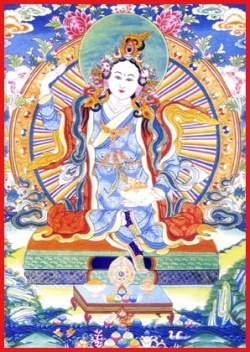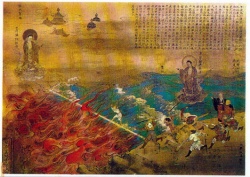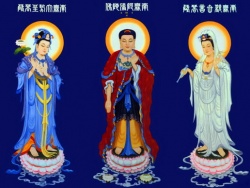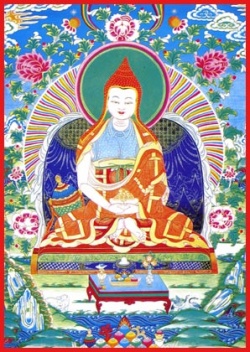Difference between revisions of "Buddhism during the Han Dynasty"
m (Text replacement - "Liang" to "Liang") |
|||
| Line 30: | Line 30: | ||
[[Buddhism]] continued to flourish during the Northern and Southern Dynasties. The now famous [[Longmen Grottoes]] and Yungang [[Caves]] were [[constructed]] during this period. | [[Buddhism]] continued to flourish during the Northern and Southern Dynasties. The now famous [[Longmen Grottoes]] and Yungang [[Caves]] were [[constructed]] during this period. | ||
| − | The most important event was when [[Bodhidharma]] came to [[China]]. He arrived in Guangzhou and then went on to Nanjing where he entered into [[discussion]] with [[Emperor]] Wu of | + | The most important event was when [[Bodhidharma]] came to [[China]]. He arrived in Guangzhou and then went on to Nanjing where he entered into [[discussion]] with [[Emperor]] Wu of Liang in the Southern Dynasty. They failed to agree over matters of [[doctrine]] and so [[Bodhidharma]] went to the [[Shaolin Temple]]. [[Bodhidharma]] was the first [[Patriarch]] of [[Zen]] [[Buddhism]], the [[formation]] of which marked the independent development of the [[faith]] in [[China]]. This localized sect had a profound repercussion on [[Chinese Philosophy]] and {{Wiki|culture}}. |
[[Buddhism]] reached its [[zenith]] during the Sui and Tang Dynasties. [[Emperor]] Wen of Sui ordered the restoration of [[temples]] and [[statues]] of [[Buddha]] that had been destroyed during Northern Zhou. Tang {{Wiki|Emperors}} claimed they were descendents of Lao Zi, the [[creator]] of {{Wiki|Taoism}} and paid homage to {{Wiki|Taoism}} but in practice they [[recognized]] the importance of [[Buddhism]]. An Institute was set up to translate [[Buddhist sutras]] in the Big Wild Goose [[Pagoda]] in the {{Wiki|capital}} city of Chang'an (today's [[Xian]]). [[Xuan Zang]] was the most reputed [[Monk]] at this [[time]], and it was his journey to [[India]] that was the model for the Ming {{Wiki|novel}} The Journey to the {{Wiki|West}} (also known as the {{Wiki|Monkey}} [[King]]). | [[Buddhism]] reached its [[zenith]] during the Sui and Tang Dynasties. [[Emperor]] Wen of Sui ordered the restoration of [[temples]] and [[statues]] of [[Buddha]] that had been destroyed during Northern Zhou. Tang {{Wiki|Emperors}} claimed they were descendents of Lao Zi, the [[creator]] of {{Wiki|Taoism}} and paid homage to {{Wiki|Taoism}} but in practice they [[recognized]] the importance of [[Buddhism]]. An Institute was set up to translate [[Buddhist sutras]] in the Big Wild Goose [[Pagoda]] in the {{Wiki|capital}} city of Chang'an (today's [[Xian]]). [[Xuan Zang]] was the most reputed [[Monk]] at this [[time]], and it was his journey to [[India]] that was the model for the Ming {{Wiki|novel}} The Journey to the {{Wiki|West}} (also known as the {{Wiki|Monkey}} [[King]]). | ||
Revision as of 10:40, 30 September 2013
Early History of Buddhism in China
Buddhism (fó jiào 佛教) is the most important Religion in China. Buddhism was introduced from India into China in 6th Century AD. One of the Hen Emperors sent a mission to the west of China and brought back the scriptures (jīng wén 经文), Indian monks and the images of Buddha. Since then Chinese translation was made available and the further exchange of scholars among China, India and other Asian countries brought about the rapid development of Buddhism in China. Buddhist monasteries (xiū dào yuàn 修道院) and temples were built to promote the Buddhism and some of the Emperors were also the followers of Buddhism. Buddhism, just like Confucianism (rú jiào 儒教) and Taoism (dào jiào 道教), guides people to behave, to be honest and responsible. It promotes harmony and peaceful mind, sharing and compassion. Buddhists never force people into their belief. Buddhism emphasizes in "awakening of mind". Through learning, one will develop intellectual capacity to the fullest so as to understand, to love and be kind to other beings.
Buddhism does not believe in God. It believes in People. In Buddhist teaching, there is no aggressive promotion of Buddhism or strong rejection of other religions. All these make Buddhism fall into the same scope of Confucianism and Taoist. Its ability to co-exist with any other religions makes it being developed into one of the largest religions in China.
Buddhist scriptures (fó jīng 佛经)
During the early Tang dynasty the Monk Xuanzang journeyed to Nalanda in India and other important sites to bring back scriptures. He sought to expand influence of Mahayana (dà chéng fó jiào 大乘佛教) over Theravada (xiǎo chéng fó jiào 小乘佛教), though the Yogacara school he preferred differs significantly from the later Chinese Mahayana schools that developed such as Pure land (jí lè shì jiè 极乐世界).
Xuanzang
Xuanzang (xuán zàng 玄奘) was a famous Chinese Buddhist monk, scholar, traveler, and translator that brought up the interaction between China and India in the early Tang period. Born in Henan province of China in 603 CE, he displayed signs of intellectual and spiritual greatness even at an early age. From boyhood he took to reading sacred books, mainly the Chinese Classics and the writings of the ancient sages. While residing in the city of Luoyang, Xuanzang entered Buddhist monkhood at the age of thirteen. Due to the political and social unrest caused by the fall of the Sui dynasty, he went to Xingdu in Sichuan (sì chuān 四川), where he was ordained at the age of twenty. From Xingdu, he travelled throughout China in search of sacred books of Buddhism. At length, he came to Chang'an, then under the peaceful rule of Emperor Taizong of Tang. Here Xuanzang developed the desire to visit India. He knew about Faxian's (fǎ xiǎn 法显) visit to India and, like him, was concerned about the incomplete and misinterpreted nature of the Buddhist scriptures that reached China. He became famous for his seventeen year overland trip to India and back, which is recorded in detail in his autobiography and a biography, and provided the inspiration for the epic novel Journey to the West (xī yóu jì 西游记).
Buddhism indoctrinated China at a time when Confucianism and Taoism were the two predominant religions prevailing in the country. In the early facet of its entry, Buddhism could not find much persuasion in China. It was only by the 2nd century AD, the religion could gain the popularity to some extent by the distinctness of its approach and due to some similarities with Taoism. Later on the Buddhist religion managed to hold a firm footing and acquired a mass following.
The arrival of many new Buddhist scholars from the Indian subcontinent and central Asia, like An Shih-Kao, a Parthinian Monk, and Lokakshema, a Kushana Monk from Central Asia, Dharmaraksha in 3rd century AD, Kumarajiva in 4th century AD, who got a number of Buddhist texts translated into Chinese gave a driving force to Buddhism that had lot of captivating characteristics besides a organized approach to the study and race of religion. During the same period many Buddhist texts were translated from Pali and Sanskrit into Chinese.
China was blessed by its own eminent Buddhist scholars with extraordinary vision like Seng-Chao, Tao-Sheng and Fa-hsien who also contributed richly to the growth of Buddhism China through their translations and knowledge.
Buddhism during the Han Dynasty was regarded as having its basis in magic in much the same way as Taoism and it first took root among members of the royal family and aristocracy. During the Three Kingdom Period, it was studied as an independent subject. Luoyang in North China became a major center where there was a focus on the translation of the scriptures while in South China Buddhism thrived in a tolerant atmosphere.
The Jin Dynasty witnessed the popularization among ordinary people. In 401 Kumarajiva was invited to Chang'an from the Western Region that lay to the west to Yumenguan Pass and together with 3,000 scholars translated 74 sutras. Obviously, this was an event of great importance to spread of Buddhism.
During the Jin Dynasty a new class emerged; that of the scholar-bureaucrats. They brought together the established, popular metaphysics and Buddhist doctrines. In the north of China there were quite a few reputed monks while in the south many scholar-bureaucrats were well versed in Buddhism. The royal families were passionate toward Buddhism and granted monks and nuns considerable privileges. The number of temples mushroomed to 1768 and with them as many as 24,000 monks and nuns. Monks were to become a new class in China and Buddhism took a firm hold on the country.
Buddhism continued to flourish during the Northern and Southern Dynasties. The now famous Longmen Grottoes and Yungang Caves were constructed during this period.
The most important event was when Bodhidharma came to China. He arrived in Guangzhou and then went on to Nanjing where he entered into discussion with Emperor Wu of Liang in the Southern Dynasty. They failed to agree over matters of doctrine and so Bodhidharma went to the Shaolin Temple. Bodhidharma was the first Patriarch of Zen Buddhism, the formation of which marked the independent development of the faith in China. This localized sect had a profound repercussion on Chinese Philosophy and culture.
Buddhism reached its zenith during the Sui and Tang Dynasties. Emperor Wen of Sui ordered the restoration of temples and statues of Buddha that had been destroyed during Northern Zhou. Tang Emperors claimed they were descendents of Lao Zi, the creator of Taoism and paid homage to Taoism but in practice they recognized the importance of Buddhism. An Institute was set up to translate Buddhist sutras in the Big Wild Goose Pagoda in the capital city of Chang'an (today's Xian). Xuan Zang was the most reputed Monk at this time, and it was his journey to India that was the model for the Ming novel The Journey to the West (also known as the Monkey King).
Hui Neng (638-713), the sixth Patriarch of Zen Buddhism, should not be ignored. His famous verses, "Originally there was no Bodhi-tree, nor stand of a bright mirror. The mirror was originally clean and pure; where can it be stained by dust?" These words have otherwise been translated as: "The Tree of Perfect Wisdom was originally no tree. Nor had the bright mirror any frame. Buddha-nature is forever clear and pure. Where is there any dust?" These lines have become the first thing to pop into the mind when people think of Zen. In 730 Hui Neng's disciples won debates with other sects and Zen was strengthened in China. Zen was introduced to Korea in the 8th Century and to Japan at the end of the 12th Century.
Buddhism penetrated daily life and had a substantial impact in architecture, sculpture, painting, music and literature. However, it was forbidden in 845 due to social and economical reasons. Over 4600 temples were demolished and 260, 500 monks and nuns were forced to give up their religion.
The combination of Buddhism and Confucianism led to the formation of Li Xue, the Confucian school of idealist philosophy of the Song and Ming dynasties. This tradition was inherited by the Qing Dynasty and Zen became synonymous with Han Buddhism.
ver its long history, Buddhism has left an indelible impact on Chinese civilization. Many words and phrases have root in a Buddhist origin. Take a colloquial phrase as an example, 'to hold the foot of Buddha at the moment" means "to make a last minute effort". This reveals in a sense the true attitude of the Chinese toward the utilitarian aspects of belief. Many people kowtow to whatever gods they encounter and will burn incense in any temple.
In literature traces of Buddhism and Zen are obvious. Quite a few famous poets in Tang Dynasty like Bai Juyi were lay Buddhists but this did not prevent them from indulging in a little from time to time. Just as today's white collar classes go to bars, the Tang scholars went to restaurants to drink and flirt with the almahs.
In today's China, Buddhist temples, Buddhist caves and grottoes and Buddhist Holy Mountains, especially the ones listed in the national or provincial historical and cultural relics, have become the hot spots for tourism. It is not uncommon for the income of a temple to cover the expenses of a whole county or district.
Tibetan Buddhism
Tibetan Buddhism, also called 'Lamaism', started in the middle of 7th century. At that time, King Songtsen Gampo married Nepalese Princess Chizun and Princess Wencheng from Chang'an (currently Xian). Influenced by these two Buddhist princesses, he coverted to Buddhism and built Jokhang Temple and Ramoche Monastery (Xiao Zhao Si). In the middle of 8th century, Buddhism was introduced to Tibet via India. Tibetan Buddhism was totally formed in the late 10th century. After centuries of development in Tibet, a unique combination of religion and politics with Tibetan Buddhism evolved.
Present Tibetan Buddhism can be divided into four sects: Nyingmapa, Kagyupa, Gelugpa, and Sakyapa.
Nyingmapa means 'old' in Tibetan. Nyingmapa is the oldest sect. It is also called 'Red sect' because monks in this sect always wear red Monk hats. The Kagyupa sect was created in the middle of 11th century, and it is famous for having the most branches. It is called 'white sect' because monks belonging to this sect wear white robes and their temples are painted white. In 14th century, Tsong Khapa created Gelugpa sect. This sect encourages monks to live an austere and unselfish life. Monks of this sect wear yellow hats, so it is called 'yellow sect'. In Tibetan, sakyapa means 'colorful'. Temples of the Sakyapa sect are painted in red, white and black stripes, symbolizing Manjusri Bodhisattva, Avalokitesvara and Vajradhara, so it is called the 'colorful sect'.
There are many Tibetan Buddhist monasteries in China, which are worth visiting to experience authentic Tibetan Buddhist culture. Famous Tibetan Buddhist monasteries include: Drepung Monastery, Ganden Monastery, Labrang Monastery, Sakya Monastery, Sera Monastery, Ta'er Monastery and Tashilhunpo Monastery.
Southern Buddhism
Dai people in Xishuangbanna Prefecture, Yunnan Province believe in Southern Buddhism. According to records, Pali Buddhism was introduced to Yunnan in the middle of 7th century via Burma but it lasted only four centuries. No temples were built and the sutras were passed on orally. Thus, Southern Buddhism faded and monks fled during the war around the 11th century. The existing Southern Buddhism entered Yunnan from Burma and Thailand after the wars.
In 1277 a written Dai language was created and the Pattra Sutra appeared. In the Ming Dynasty a Burmese princess was married to a local ruler in Dai area and Burmese monks were sent to Yunnan. A large quantity of Buddhist temples were built in Jinghong . All these helped to popularize Southern Buddhism among the common people.
With its combination of religion and politics, Southern Buddhism, absorbing Tai culture, has flexible doctrines. Monks can eat meat and can secularize. Women do not become nuns for to do so would break their ancestral line.
Generally, Buddhism is the single religion among Dai people and has a comprehensive influence over their daily life and culture like sculpture, painting and folklores. Young boys must go to the temples and learn knowledge until they become adults. Some remain in the temples and become monks while others return to secular life. In a sense, monks assume the role of imparting ethnic culture.



